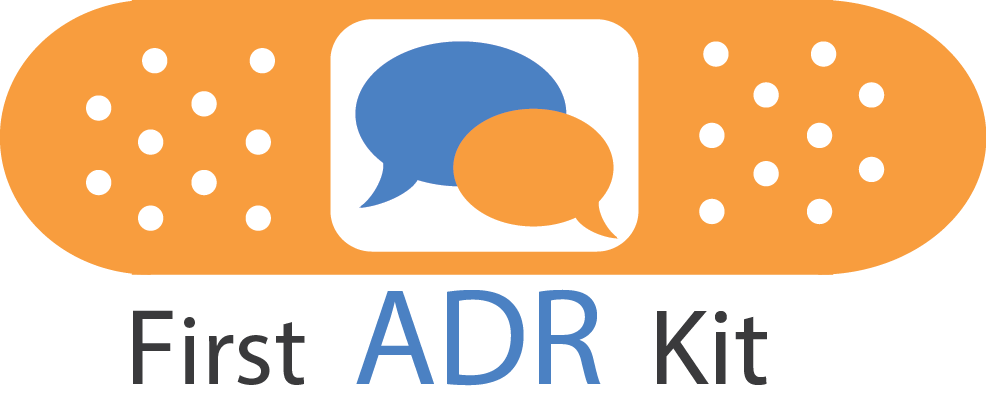What is the place of mediation in youth work?

For a long time mediation was associated with the closed spaces of courts or the cold walls of business offices, occupied by lawyers and serious gentlemen in suits, trying to divide their incomes in the most efficient way. Luckily, due to many educational initiatives and public campaigns, mediation is getting more recognised as a process of facilitating resolution of all types of conflict, ranging from family affairs to everyday disputes with colleagues or friends.
The definition of mediation is very simple: it is a process where two or more parties decide to reach an agreement with the support of a third, neutral party, a mediator. The mediator is not a judge or counselor, but a facilitator: he or she helps the parties to communicate and find common ground instead of giving them advice or proposing how to solve their dispute. The final agreement is solely the result of discussions between the parties to the conflict. And, if agreed upon, it can be equally binding as a court’s decision. Mediation is based on five fundamental principles: voluntarism, impartiality, neutrality, acceptability and confidentiality.
Knowing what mediation is about, it is no surprise that it can also be used in youth work. More and more initiatives are trying to promote mediation among young people or in work with youth. If you are a youth worker yourself, maybe you have already stumbled upon this idea and are wondering now, is there a place for mediation in my work as a social worker, teacher, facilitator or volunteer? What can I get from it and how can I implement it in my everyday work?
Having worked on the implementation of mediation in youth work for six years now – while organising different training courses and strategic partnerships all around the European Union and Partner Countries, we have become confident that there are many things you can take from mediation and implement in your daily life as a youth worker or a local leader. We would like to share with you some examples of outcomes and initiatives that you can work on if you ever decide to focus more on mediation.
What can you take from mediation as a youth worker?
1. Understanding Positions, Interests and Needs
The main goal of the mediator, while facilitating a conflict resolution process, is to help parties understand their positions, interests and goals. Positions are the statements and behaviours that people demonstrate when they enter into a conflict. They are usually demands, expressed in a closed and defensive way (‘I want…!’, ‘I will not do…!’) Interests lie beneath positions: they show what a person is really trying to achieve (‘What do you need this for?’) Needs are even deeper: they relate to the most common human needs (such as on Maslow’s pyramid). Being able to move the conflict from the level of positions to interests and needs gives much more flexibility in finding solutions and that ability can be used in many dimensions of youth work.
2. Active listening techniques
In mediation, the mediator will often use different active listening techniques. They will allow him or her to understand the parties and their interests better. If you ever participate in a training course or an event that focuses on mediation, you will most probably be able to practise active listening techniques in a conflict context (these will include: asking confirmatory questions, using your body language, paraphrasing and giving feedback and summarising).
3. Methods and structure for a conflict resolution process
One of the biggest issues for new mediators while approaching a conflict is: ‘How do I actually start?’ ‘Should I organise a meeting for everyone involved, who should speak first, how far should we go, to what extent should I intervene?’. Mediation gives you answers to all of these questions and more. Studying mediation, you can figure out your own preferred process of facilitating conflict resolution, based on verified structures and examples. You will also gain more confidence in ‘chairing’ a conflict and know when to mediate and when to stop.
4. Ability to deal with emotions in conflict
While talking about emotions in mediation we often relate to the concept of 3xR rule: Recognise, Respect, Respond. Recognise that the other person is feeling emotions. Do not neglect them or hide them. Respect the emotions. Do not judge or try to turn the attention towards yourself. Respond to the other person’s emotional state. Show support or try to join in with his or her happiness. Learning about mediation you will also learn how to implement that rule in practice and how to help conflicted parties deal with their emotions.
5. Freedom and creativity
Using mediation as a tool to solve conflicts also means being creative and open to new solutions. Mediation does not limit you in the possible outcomes. Once the parties start to talk with each other, you can encourage them to be as imaginative as possible and try to see the problem from each other’s perspective. It will not only help them to understand each other better but also allow them to find solutions that would not normally be available in any other conflict resolution method.
What can you give back to the community?
1. Training courses and workshops
Learning new tools and approaches is always the most valuable way you can give back to your community. There are many teaching resources available on practising mediation with your youth groups, but also with your peers, colleagues or friends. Some of those are available on our webpage http://firstadrkit.org/intellectual-outputs/ Sometimes a short workshop or two can be life changing and have a very positive influence on your groups.
2. Establishing social mediation in your organisation
Conflicts happen not only among youth but also within organisations, between your colleagues, employers and employees. You can consider establishing a more structured system for reacting to these situations, such as internal mediation or social mediation in your workplace and organisation. Coming with a conflict to a trusted peer who will remain neutral and try to weigh the interests of both parties can help minimise the risks and decrease tensions before they have a chance to erupt into a bigger dispute.
3. Empowering young people
The benefits you gain while entering into mediation go beyond solely finding a solution to a problem. Each young person, that is engaged in mediation and will work on resolving a dispute with your support, will learn that conflicts are manageable and they, the young people, have a direct influence on their outcome. They will also experience how good communication and openness can help them in their daily struggles and gain confidence and a sense of ownership of their actions and interests.
4. Being a local leader of change
One of the distinctive features of mediators is that they are usually widely respected in their communities. Their role in the conflict is to remain impartial and supportive, which should help build trust between the mediator and parties to the conflict. This potential can be used beyond the mediation setting. Use the trust and relationships you have built for advocating for your community, representing them in what really matters and leading them towards social and personal changes.
5. Sustainability
Quite often social issues and conflicts that seemed to have been resolved in the past erupt again in the future in a more complicated and destructive way. Only from that future perspective will we discover that the conflicts were never truly solved, just placated. Solutions were not agreed upon but imposed and neglected the real needs of the parties. Mediation helps you to avoid that loop. Focusing most importantly on accommodating needs and acceptability, mediation guarantees that the final solutions you reach can be sustainable and will help to build a better and stronger society.
So what is the place that you will choose for mediation in your daily life?
Paulina Opiełka
—
This article has been developed within ‘Ready to Mediate? Direction: Youth!’ project organised within the scope of Erasmus+ programme and co-financed by the European Commission. This publication reflects the views only of the author, and the Commission cannot be held responsible for any use which may be made of the information contained therein.



